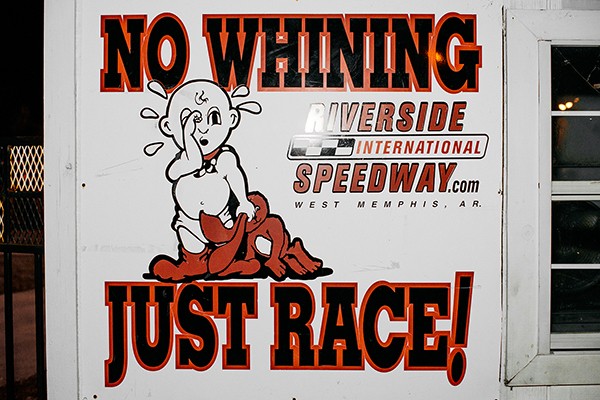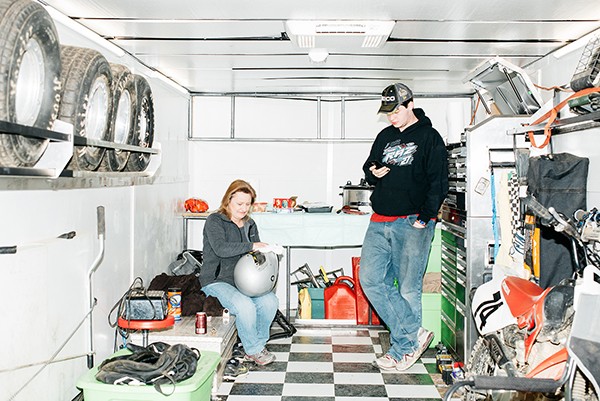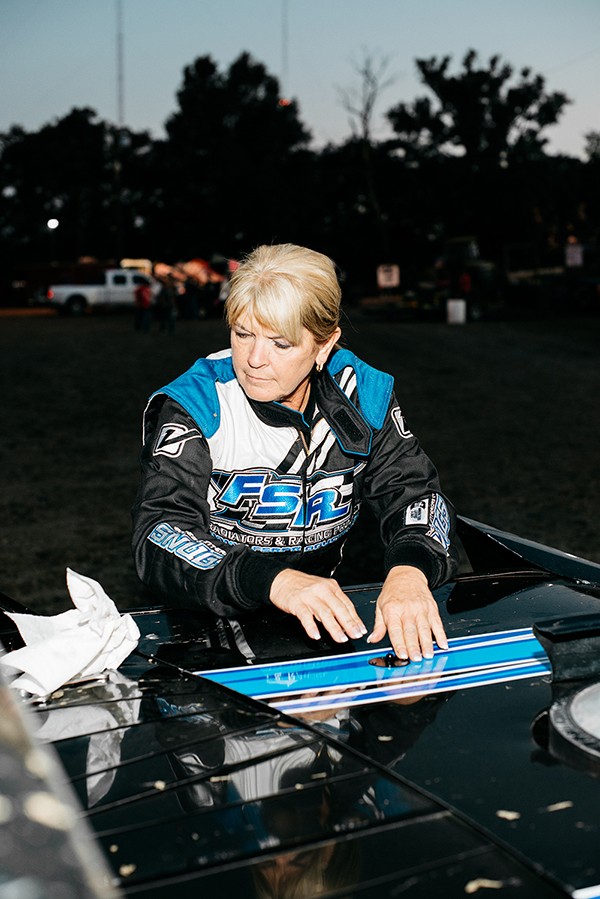It would be easy to miss the Riverside Speedway if you didn’t know where you were going. You can find the oval dirt track, known to regulars as The Ditch, at a sharp turn off I-55, just across the old bridge in West Memphis, Arkansas. There, a white building marked “American Legion” and a grassy parking lot backdrop the country’s oldest continuously operating dirt racetrack. If you pass by the track on a Saturday evening between 7:30 and 10:30, you’ll hear the unmuffled thunder of hand-built engines. It’s loud, but loud doesn’t quite get it. To explain the sound of 15 revving engines in musical terms: It’s as ugly as a Guns N’ Roses revival tour, but as exciting and all-around-American as Guns N’ Roses in 1987, in their “Welcome to the Jungle” era. The Riverside Speedway is a place worthy of a guitar solo, or six.
When I visited on an evening in late May, the races hadn’t started yet. The sun was setting and cut long shadows through the bleachers. A small crowd was gathered around the concession stand. I picked up my tickets from a booth with a sign on the front that read, in an emphatic red font: “NO WHINING, JUST RACE.” I made a mental note to not whine, and just race.

Beyond the gate was a mud pit, permanently indented with tire tracks, where the drivers and their crews set up white trailers for the night. The air smelled like burning rubber and fry oil, but not in a bad way.
The drivers, men and women from 16 to into their 60s, wore customized fire suits and tinkered with their cars. The cars looked, variously, like crumpled aluminum cans, or — in the case of the pint-sized sprint cars — like Mad Max for a tribe of post-apocalyptic fourth graders.
There were several different models lined up to race that evening, and the pit was crowded with “stocks,” “modifieds,” and “wing sprints.”
Dirt racing cars are distinct from their NASCAR cousins in that they have more character and variety. They are also more homespun. The stock cars at the speedway look like they are purely cage, motor, and sheet metal. The modifieds have a kind of aerodynamically raised back and special rear suspension, like country Batmobiles. Wing sprints look like single-rider cartoon go-carts, except with 800 horsepower and topped with tilted rectangles of sheet metal to keep them on the ground.
These cars are mostly built by the folks who drive them, or friends and relatives of the folks who drive them, and so it’s not wrong to guess at how the character of the vehicle relates to the character of its owner. Many have the driver’s name printed on the side, plus a number. I noticed one with a bold script across its back that read “2 Hard 2 Tame” and tried to imagine something similar printed on my Prius. No dice.
I traded a little cash for a corndog and a plastic bowl of fries before meeting up with Tommy Mullins, the speedway’s race director. Mullins has a kind face and the kind of Southern accent you might expect from a West Memphis racetrack director. He wore a ballcap, headset, and dirt-caked sneakers as he toured me around the track in his golf cart. Mullins, like virtually everyone at the races, is a dirt track lifer. He got hooked in his early twenties (later than most people, he pointed out) and has devoted himself to what he calls “a very expensive hobby” ever since, even though he doesn’t race anymore.

Speedway aficionados pause for snacks.
As Mullins and I talked, the stands begin to fill and dusk settled over the track. ‘Tween girls wearing pink noise-cancelling headphones self-segregated from their younger brothers. Grandfathers and babies and teenagers on dates all posted up in the bleachers. The pit was similarly age-diverse. People gathered around their trailers or assisted with the cars.
“We’ve got kids out here now who are racing their grandmothers or grandfathers,” said Mullins. It makes sense: The Speedway has been operating since 1949, mostly with the same crowd of about 200 families from various corners of the Mid-South. When people talk about being “in the life,” they mean it. The Riverside Speedway must be one of the only spots in the world where you can drive a thousand pounds of sheet metal at 100-something miles an hour and be competing with your grandfather.

A family (above) prepares to race.
Mullins drove his golf cart over the crest of the dirt track and into the infield (“It’s pretty special to see things from out there”), where we watched as modifieds lined up for what are called heat races, or qualifying rounds. Before the races kicked off, we paused for a stadium-wide prayer. The announcer asked that God watch over recent graduates, the races, the armed forces, and the country. We sang the National Anthem, hands over our hearts.
The cars circled, bumper to bumper, before kicking into high gear. As they sped around the oval, flecks of mud and rubber showered over the thin divider fence and into the stands. At the turns, the bodies of the cars raised up so that the wheels slipped under them. The track is a classic short track, a quarter of a mile in all, as opposed to the two-mile-long superspeedways that you can find at Talladega. I felt as if I could barely glance at a car before it had already circled me again.
As the cars pulled through the infield to be weighed, Mullins pointed out last year’s winning drivers, and others who’d been around the track for years. He told everyone who drove through: “Good job out there.”
I asked him if he had favorite drivers. “Oh, you know, I try to stay impartial,” he said. “But I root for people who have either been doing it for a long time or young people with a lot of energy. And good sports. I appreciate good sports.”
Dirt track racing is a sport with a long history. Popularized in the 1920s, it is the progenitor of races like Talladega and the Indy 500 but remains as unpretentious today as it was in the early 20th century. You don’t need to know anything about the sport to have a good time at the races, but if you’re interested in the nitty-gritty, the best method might be just to go to the track and hunt down the oldest-looking guy or gal you can find, buy them a beer, and listen.
The weekly program, a glossy magazine full of pictures of racers and their cars, spells it out: “Come to Riverside International Speedway every Saturday night with your friends and family for a fun-filled night with thrills, chills, and spills, YOU WILL LOVE IT! COME ONCE AND YOU WILL WANT TO COME EVERY RACE NIGHT!!”
You can also do what I did to prepare and randomly search YouTube for “dirt track racing” and listen to a playlist of the top five songs about dirt track racing, the best of which is surely a rap-country crossover by a man named Kenny Montgomery, from his mixtape King of the Kuntry 4, called “Dirt Track Thing.” In “Dirt Track Thing,” a viral hit, Montgomery provides a complete lexicon of dirt track racing terms and talks about his “waffle house queen” (“Yeah buddy, that’s a dirt track thing”). It’s educational. Mullins drove me back to the pit when he went to turn on the stadium lights, a nightly task, and introduced me to a driver named Linda, who’d come out to compete in the stock car competition. Linda Kerbough had a new car, and, when I met her, she was frustrated that it wasn’t running like she wanted it to run.

Linda Kerbough works on her stock car.
“It’s a little loose,” she said, unapologetically. “I don’t usually look like I do out there tonight.” She was dressed in a fire suit with her name illustratively printed across the belt. Her blonde, layered hair was swept up in a casual ponytail. She was wearing diamond earrings, and, I noticed, she sported a French manicure. Stylish.
Mullins had described Linda as “a character,” which, after meeting her, I translated into “a powerhouse.” She told me that she’d worked a 70-hour week at her job in medical management, before spending her remaining waking hours trying to get her new car in order.
“You live, eat, breathe, and sleep it,” she said, casually removing a piece of sheet metal from the front of the car and peering in with a metal flashlight. “I built motors for 21 years. There’s not much I can’t do out here now.” Linda directed my attention to a crew of men that were busy with various tasks around her: “That over there is my ex-husband, and there is my … well, I guess you’d call him my ex-step-grandson, but he’s just my grandson. He’s racing tonight.”
The ex-step-grandson in question, a cherub-faced teenager named Clay Coldwell, walked over to us. I asked him what it was like to race against his grandmother. “We’re related most of the time,” Clay said, smiling. “But out there, it’s like we never met.”

Clay Coldwell
Linda nodded, “Yeah. He’s just another car. He’s competition. Everyone is your competition.”
When I settled into the stands to watch the stock car race, the announcer was talking about his grandkids over the PA system. “We’re really proud of the recent graduates,” he said. “I have a granddaughter who just graduated from LSU.”
I looked around at the kids and parents who’d made it out, imagining that they’d probably still be coming to the track however many graduations, marriages, funerals, and family reunions later. At that moment, dirt track racing seemed less like an event and more like a way to arrange your life — like collecting art or scuba diving or playing multiplayer video games. Only more fun and with your whole family. It’s just a guess, but families who built motors together and kick up this much dirt probably need less therapy than most.

The feature race for the stock cars started. I kept an eye on number 26, an apocalyptic-looking black car that looked like it had driven through several circles of hell to arrive in West Memphis. I also noticed Clay Coldwell, in an orange car, number 18, hanging out in fourth place. Coldwell’s car looked like it was made out of a fine foil and a sturdy set of K’NEX. Linda was somewhere behind, in a car emblazoned with a blue skull on the hood and the number 66. The front-runners were number 1001, Ricky Vandergriff — who, I was told, was last year’s champion — and, close behind him, number 53, driven by Nathan Brown.
For 15 laps, Vandergriff and Brown kept it neck-and-neck. At times, I would think that 53 was gaining, only to see 1001 pull into the lead. The cars got dangerously close to one another, to the point where I thought that they might knock each other off-course. I’ve driven a race car once, and not very fast, but the experience bears almost no similarity to regular driving: You can feel every effect of the G-Force. It’s like being on a roller-coaster that you are controlling. In this case, it’s like a roller coaster you are controlling on dirt.
As Vandergriff gained the lead, I overheard a small boy, a couple rows in front of me, yell, “Every race I come to! Every race I seen, he wins!”
An official in a box overlooking the track waved a white flag, meaning there was one lap left. The sound of the engines was overwhelming as Vandergriff roared into the curve. When the official waved the white checkered flag signalling the finish, many people were on their feet, cheering.
Vandergriff pulled through to have his car weighed, and then parked, as did Brown. Two teenage girls wearing racetrack tees carried a large stock card that proclaimed “Feature Winner!” to Vandergriff, a middle-aged man whose features I couldn’t make out at distance, except to see that he was smiling. Everyone posed for a photo in front of the car. Brown walked up, and he and Vandergriff also posed for a photo.
“Look, there’s Nathan Brown posing with him right after he almost spun him out,” commented the announcer. “That’s friendship right there, folks.”
If you’d asked me a few weeks ago to describe to you the most quintessentially American scene that I could possibly imagine, I’d have described something that wouldn’t even come close to the consummate American-ness of the Riverside Speedway, which may be the most American place in America. They have fast cars, country music, corndogs, hamburgers, Budweiser in cans, an American flag, enthusiastic crowds of 8-year-old boys with buzzed hair, women in jean cut-offs, and lots of mud. The drivers, Mullins mentioned, have plastic visors on their helmets that they can rip off and replace “when a big ol’ hunk of mud hits you in the face.”
It’s also American in that “make your own fun” kind of way. As the night went on, I watched cars catch on fire, run out of gas, spin out, and lose metal from their bodies. The modified race started with what looked to be 15 or 20 cars but stopped almost every other lap when disaster struck a driver, and his ride had to be towed off the track. The sprint races (two separate events — for “360 Wing Sprints” and “2-305 Wing Sprints,” which denotes a size difference) were even more high-octane, with the cars running at around 120 miles an hour in a muddy circle. I watched this last race from a set of stands in the pit, where it felt like at any moment the small cars might upend and crush us.
As the night drew to a close, the drivers loaded their vehicles into the trailers. It had been a quiet night at the track. I could see drivers and owners taking account, looking over the distress to their cars, calculating their chances for next Saturday.
I wandered the pit and ended up in conversation with a wiry man named Lynn Irwin, who has raced a modified and a stock car. Irwin’s elder daughter, April, also races, while his other daughter, Chelsea, who is 18, has been a trophy girl for several years. (“Being a trophy girl can be really nerve-wracking, especially when it’s your family out there!” said Chelsea.) April, Lynn said, was out for the season. He smiled: She’d just found out she was expecting a child.
Lynn smoked a cigarette as I asked him how the night had gone for him. “Well, one of the cars raced okay.” He nodded towards a second trailer, “The other, not so much.” He didn’t seem that concerned as he loaded the cars up and headed home for the night.
After all, there was always next Saturday.